HIDDEN PLACES
KadS 2015 [Kunst aan de Schinkel]
Soledad Senlle Art Foundation is organizing the third edition of KadS[Art at the Schinkel]in South Amsterdam. Ten artists have been invited to produce new work in the public space in this neighbourhood, based on the theme of Hidden Places. The title is not only intended to suggest the notion of concealed and anonymous, local sites, but also that of the hidden places in ourselves. By means of site-specific artistic interventions, these hidden places will be temporarily revealed.
What is involved in the hidden places in the city and what was their significance in the past? There are places that we pass by many times, but which we don’t really know or else have failed to notice properly. These sites conceal stories and secrets. Have these hidden places remained hidden for a reason?
For instance there is the former House of Detention on the Havenstraat; with its domed roof and barred windows, this is a formidable building. And yet many residents of Amsterdam, even in the actual neighbourhood, do not know that it was a prison until quite recently, or that it was used during the Second World War to incarcerate members of the Dutch resistance and others who gave support to people who had gone underground. Many of them were executed by firing squad in the courtyard of the prison.
Another concealed site is the cellar under the Zeilbrug. A small flight of steps under the bridge leads to a fascinating room that formerly housed the hydraulic gear used to raise and lower the bridge. On the corner by Soledad Senlle behind a dense hedge of trees and shrubs the ancient graveyard of Huis te Vraag lies hidden. With its overgrown tombstones, it has been converted by its administrator, the artist Leon van der Heijden into a green miracle, which has so far only been discovered by a few people.
Hidden, anonymous places can also serve as a metaphor for the invisible side of human beings. Everyone has had ideas or fantasies that, consciously or otherwise, remain in their minds – desires, dreams or fears that are never openly acknowledged, expressed or acted on. The artists involved in the project have been asked to explore the inner self as a hidden place in human beings, the place where the soul may dwell. It is the choice of each individual what one feels able to reveal to the outside world and what one prefers to keep hidden. Another person can therefore only partially become acquainted with the deepest essence of any individual.
These internal, invisible places and the hidden sites in the public space will be temporarily revealed by the artists involved in KadS 2015. Visitors, passers-by and residents of the neighbourhood will be able to engage in a dialogue with what the artists are disclosing or else withholding. Between creation and interpretation lies the unnameable: our own hidden image that we have of something, someone or ourselves.
In addition to an art route past the art projects on various sites, educational guided tours, artist’s talks and lectures are planned.
The artists taking part are Virginie Dubois, Roos Groothuizen, Lennart Lahuis, Ola Lanko, Lucia Luptáková, Jeroen van Loon, Isabel Miquel Arques, Emmeline de Mooij, Leonard van Munster, Michiel van Nieuwkerk; Olivier de Sagazan will perform at the opening.
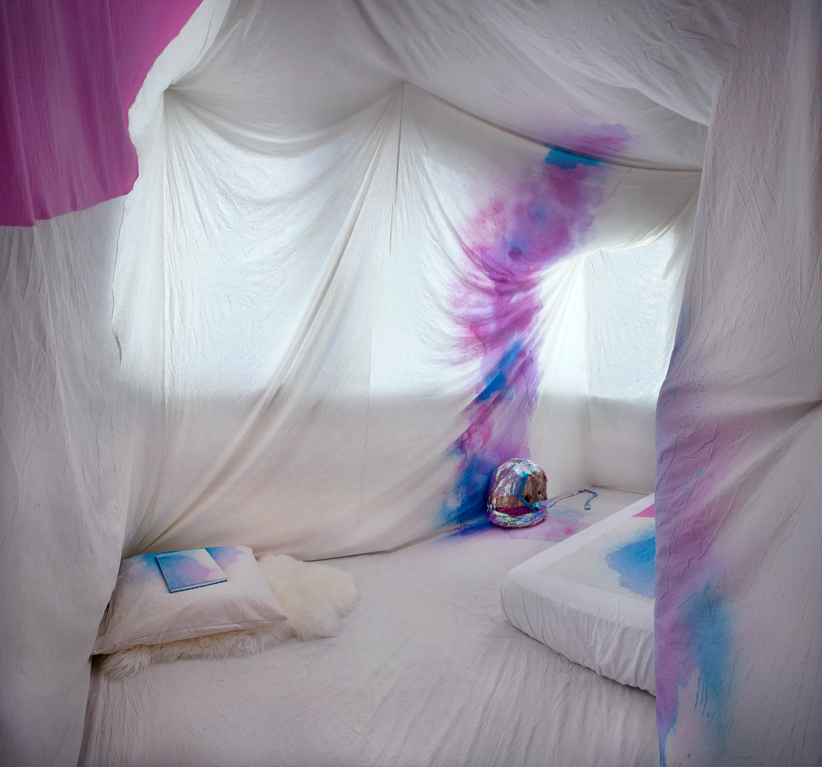
Emmeline de Mooij (NL) 24-HOUR MONASTERY, 2015
Interior, mixed media, sound installation,
Théophile de Bockbrug, Amsterdam
Anyone who is in need of calm and contemplation in this 24-hour economy can withdraw for 24 hours for free in a room designed by Emmeline de Mooij in a former bridgemaster’s house. Even though this 24-hour monastery is located in the middle of the city, the visitor will be able to cut himself off from the surroundings and his everyday worries. In the space there is just a bed and a mysterious object, to which one can talk, pray or confess as desired. It is connected to a remote control by a cord and resembles a placenta complete with an umbilical cord. Given that no other equipment is present (and cannot be brought along either), communication with the outside world is impossible and the guest can come to himself completely here. The entire space is shrouded in cotton fabric that is painted here and there with friendly colours, so the visitor cannot look outside and must focus on himself. The translucent fabric serves almost like a womb and gives the visitor a sense of safety.
Themes such as femininity, motherhood, care and therapy play a major role in Emmeline de Mooij’s work. She uses various techniques and media, including performance, installations and photography. Typical of her work are the organic splodgy forms, feminine light colours and especially the humour with which she handles the themes in her work. Often the visitor is expected to actively participate in her work. Emmeline de Mooij thus counteracts any sense of a work of art being a static object that is purely meant to be looked at.
Emmeline de Mooij [NL, 1978] studied at the Rietveld Academy in Amsterdam [Fashion, 1998-2002], the School of Visual Arts in New York [Photography, 1999-2010], and Bard College in New York [Fine Arts (ma), 2011-2014]. She was nominated for the Prix de Rome [2013] and for the Volkskrant Art Award [2014].
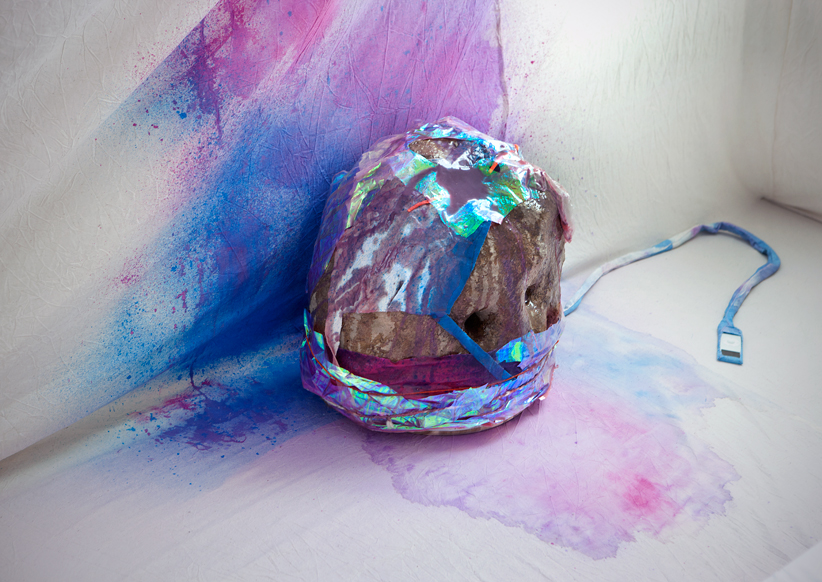
Emmeline de Mooij (NL) 24-HOUR MONASTERY, 2015
Interior, mixed media, sound installation,
Théophile de Bockbrug, Amsterdam
Anyone who is in need of calm and contemplation in this 24-hour economy can withdraw for 24 hours for free in a room designed by Emmeline de Mooij in a former bridgemaster’s house. Even though this 24-hour monastery is located in the middle of the city, the visitor will be able to cut himself off from the surroundings and his everyday worries. In the space there is just a bed and a mysterious object, to which one can talk, pray or confess as desired. It is connected to a remote control by a cord and resembles a placenta complete with an umbilical cord. Given that no other equipment is present (and cannot be brought along either), communication with the outside world is impossible and the guest can come to himself completely here. The entire space is shrouded in cotton fabric that is painted here and there with friendly colours, so the visitor cannot look outside and must focus on himself. The translucent fabric serves almost like a womb and gives the visitor a sense of safety.
Themes such as femininity, motherhood, care and therapy play a major role in Emmeline de Mooij’s work. She uses various techniques and media, including performance, installations and photography. Typical of her work are the organic splodgy forms, feminine light colours and especially the humour with which she handles the themes in her work. Often the visitor is expected to actively participate in her work. Emmeline de Mooij thus counteracts any sense of a work of art being a static object that is purely meant to be looked at.
Emmeline de Mooij [NL, 1978] studied at the Rietveld Academy in Amsterdam [Fashion, 1998-2002], the School of Visual Arts in New York [Photography, 1999-2010], and Bard College in New York [Fine Arts (ma), 2011-2014]. She was nominated for the Prix de Rome [2013] and for the Volkskrant Art Award [2014].
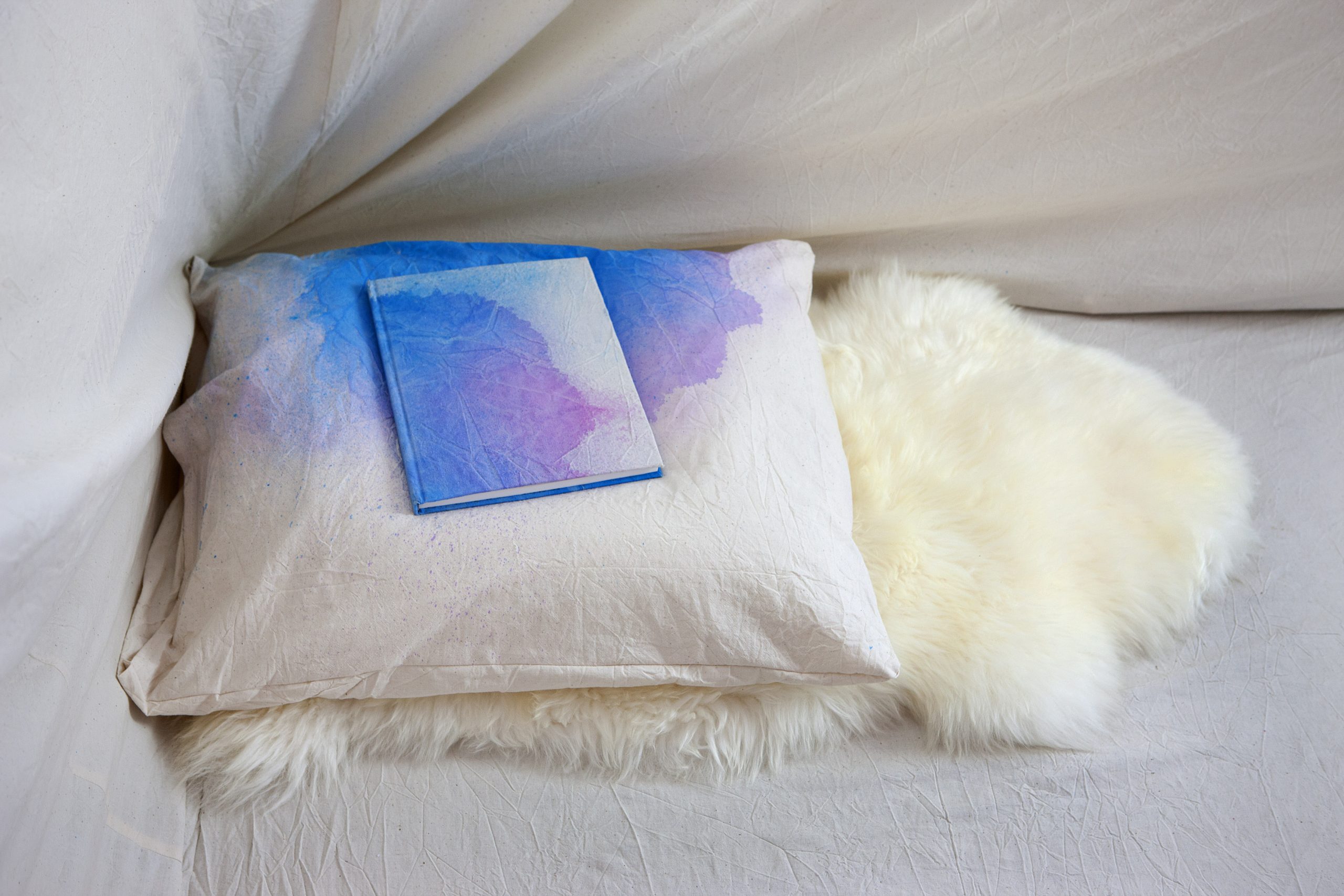
Emmeline de Mooij (NL) 24-HOUR MONASTERY, 2015
Interior, mixed media, sound installation,
Théophile de Bockbrug, Amsterdam
Anyone who is in need of calm and contemplation in this 24-hour economy can withdraw for 24 hours for free in a room designed by Emmeline de Mooij in a former bridgemaster’s house. Even though this 24-hour monastery is located in the middle of the city, the visitor will be able to cut himself off from the surroundings and his everyday worries. In the space there is just a bed and a mysterious object, to which one can talk, pray or confess as desired. It is connected to a remote control by a cord and resembles a placenta complete with an umbilical cord. Given that no other equipment is present (and cannot be brought along either), communication with the outside world is impossible and the guest can come to himself completely here. The entire space is shrouded in cotton fabric that is painted here and there with friendly colours, so the visitor cannot look outside and must focus on himself. The translucent fabric serves almost like a womb and gives the visitor a sense of safety.
Themes such as femininity, motherhood, care and therapy play a major role in Emmeline de Mooij’s work. She uses various techniques and media, including performance, installations and photography. Typical of her work are the organic splodgy forms, feminine light colours and especially the humour with which she handles the themes in her work. Often the visitor is expected to actively participate in her work. Emmeline de Mooij thus counteracts any sense of a work of art being a static object that is purely meant to be looked at.
Emmeline de Mooij [NL, 1978] studied at the Rietveld Academy in Amsterdam [Fashion, 1998-2002], the School of Visual Arts in New York [Photography, 1999-2010], and Bard College in New York [Fine Arts (ma), 2011-2014]. She was nominated for the Prix de Rome [2013] and for the Volkskrant Art Award [2014].
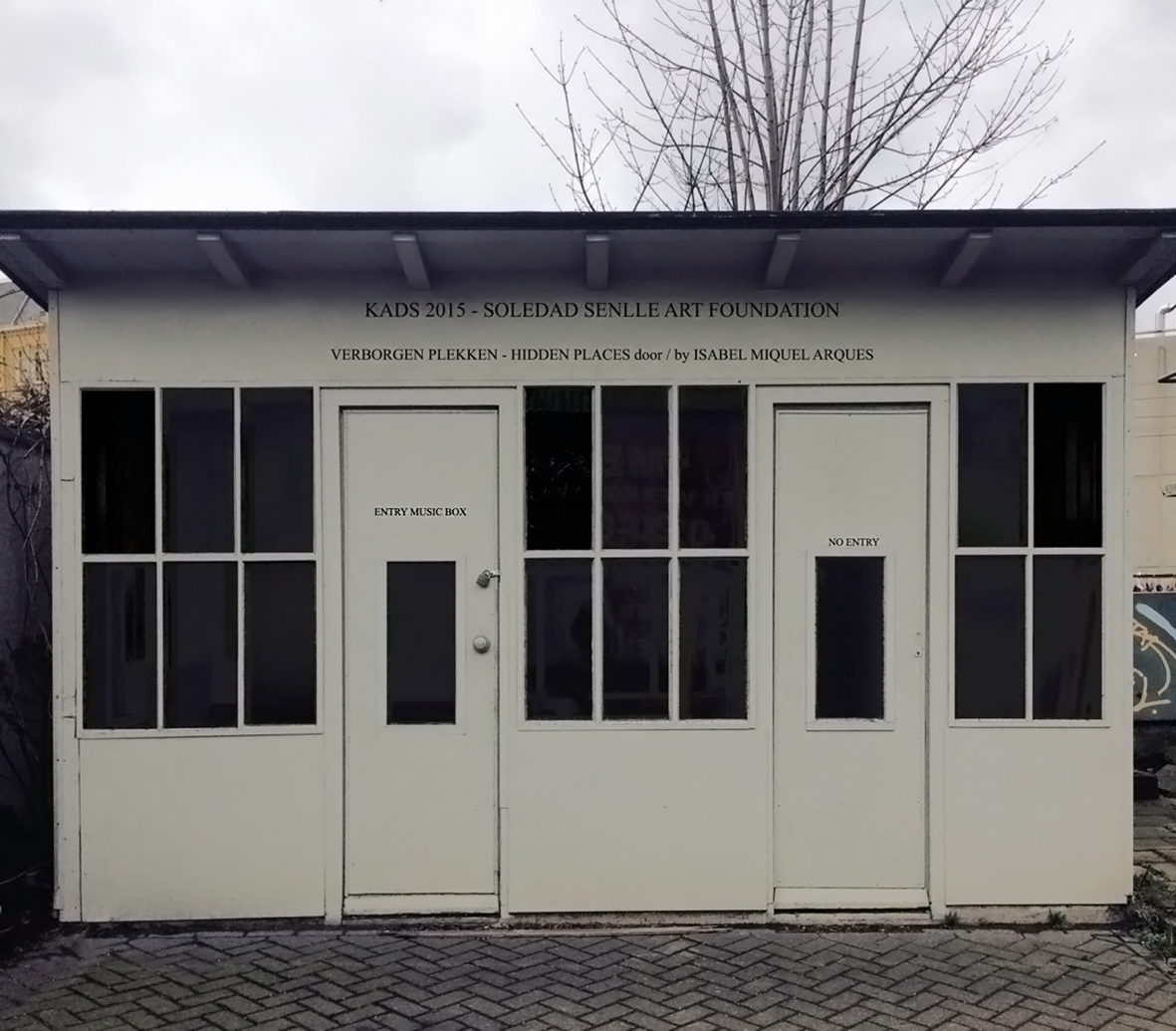
Isabel Miquel Arques (ES) MUSIC BOX, 2015
video and audio installation,
havenstraat, Amsterdam
Concealed behind a hedge of green shrubs lies the Huis te Vraag cemetery, which is no longer in use but can still be visited. The tombstones have become overgrown with ivy and other plants. It is a green oasis of calm in the middle of the city and it really seems as if time stands still here. Present and past flow together there. It raises questions about life and death, beauty and transience. Isabel Miquel Arques took the atmosphere of Huis te Vraag (House of the Question) as her fount of inspiration. She compares this cemetery with a music box where deep emotions remain put away under the lid, and which is only opened occasionally.
During KadS, the Museum Tramline’s Eindpunt-house (Terminus hut) functions like a music box that contains an impression of Huis te Vraag by Isabel Miquel Arques. When the visitor opens the door to the waiting room, it is as if he is actually opening a music box. Within, there is an audio and video installation on a continuous loop; a musical composition integrates sounds of the city and Huis te Vraag that were recorded at the cemetery together with the projected video images. This work takes visitors on a mental journey to Huis te Vraag, unveiling this hidden location as well as any hidden questions and feelings that such a place evokes.
Isabel Miquel Arques primarily shoots photographs on location, improvising and working with the ingredients she encounters there. These are chiefly portraits, but still-lifes and landscapes as well. She feels it is important to capture the atmosphere in a photo. Her photos are not in one particular style, though they are characterised by soft tones, natural light and their poetic nature.
Isabel Miquel Arques [ES, 1963] lives and works in Belgium. She has been working as a self-taught photographer for many years and is represented by Ingrid Deuss Gallery in Antwerp.
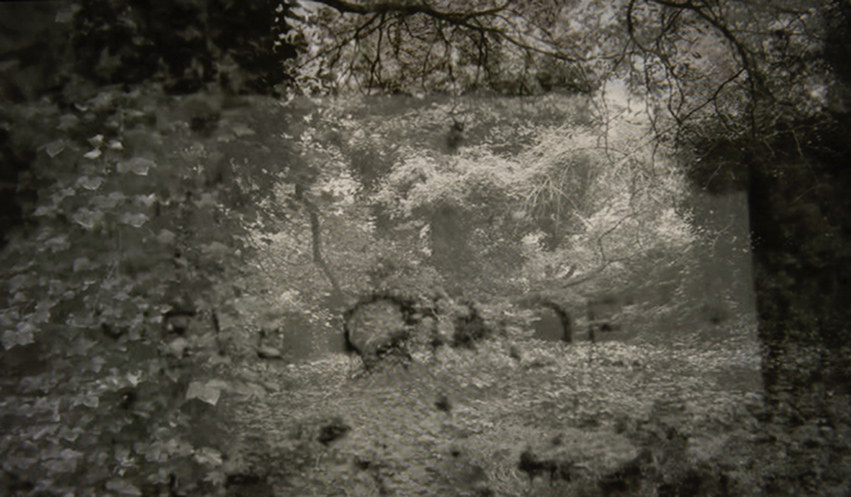
Isabel Miquel Arques (ES) MUSIC BOX, 2015
video and audio installation,
havenstraat, Amsterdam
Concealed behind a hedge of green shrubs lies the Huis te Vraag cemetery, which is no longer in use but can still be visited. The tombstones have become overgrown with ivy and other plants. It is a green oasis of calm in the middle of the city and it really seems as if time stands still here. Present and past flow together there. It raises questions about life and death, beauty and transience. Isabel Miquel Arques took the atmosphere of Huis te Vraag (House of the Question) as her fount of inspiration. She compares this cemetery with a music box where deep emotions remain put away under the lid, and which is only opened occasionally.
During KadS, the Museum Tramline’s Eindpunt-house (Terminus hut) functions like a music box that contains an impression of Huis te Vraag by Isabel Miquel Arques. When the visitor opens the door to the waiting room, it is as if he is actually opening a music box. Within, there is an audio and video installation on a continuous loop; a musical composition integrates sounds of the city and Huis te Vraag that were recorded at the cemetery together with the projected video images. This work takes visitors on a mental journey to Huis te Vraag, unveiling this hidden location as well as any hidden questions and feelings that such a place evokes.
Isabel Miquel Arques primarily shoots photographs on location, improvising and working with the ingredients she encounters there. These are chiefly portraits, but still-lifes and landscapes as well. She feels it is important to capture the atmosphere in a photo. Her photos are not in one particular style, though they are characterised by soft tones, natural light and their poetic nature.
Isabel Miquel Arques [ES, 1963] lives and works in Belgium. She has been working as a self-taught photographer for many years and is represented by Ingrid Deuss Gallery in Antwerp.
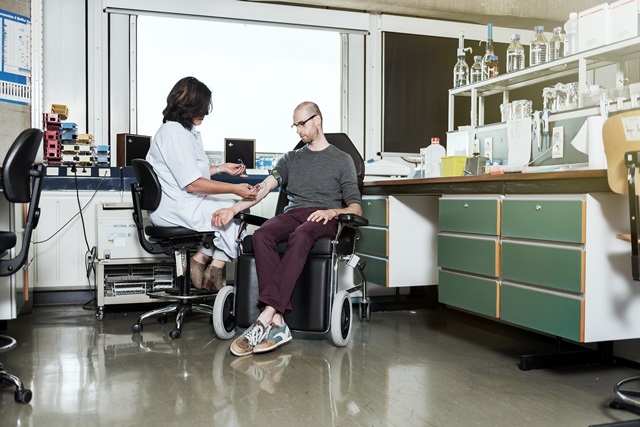
() CELLOUT.ME, 2015
installation and website,
Sloterkade 171, Amsterdam
What is the value of someone’s DNA? Can these sensitive private data simply be sold and is it possible to become the co-owner of someone else’s DNA data? In that case, what does this mean for the privacy of whoever hands over his DNA, and what does this mean for his family? DNA is the storehouse of the most personal data, the vector of hereditary information. The technique of reading out DNA is becoming easier, quicker, cheaper and thus more accessible. What are the ethical, financial and social consequences if this unique private data are traded, end up on the internet and are available to businesses and other organisations?
The Cellout.me art project investigates all these questions. Specially for KadS, Jeroen van Loon is not only exhibiting his DNA data; he is actually offering it for sale! He has given his blood to the Erasmus MC to have his DNA read out. His complete DNA sequence to laboratory standards of 380 GB has been stored on a server, and it can be consulted via a screen. He is also presenting photos of his visits to the genetic laboratory, taken by Erik Borst, and the responses of various professionals to the question of what value personal DNA data actually possesses. His DNA will be publicly auctioned via the www.cellout.me website, where people can place a serious bid in order to become joint owner of this artist’s DNA. The purchaser of this artwork will become the owner of the artist’s ultimate self-portrait.
In earlier work Jeroen van Loon examined the impact of internet and digital culture on daily life and our thinking about privacy.
Jeroen van Loon [NL, 1985] studied at the HKU in Hilversum [Digital Media Design, 2006-2010] and the HKU/The Open University, UK [European Media Master of Arts (ma), 2010]. He has given TEDx talks in the Netherlands [2012/2014], was nominated for the Designers & Artists 4 Genomics Award [2012], and won the European Youth Award [2012].
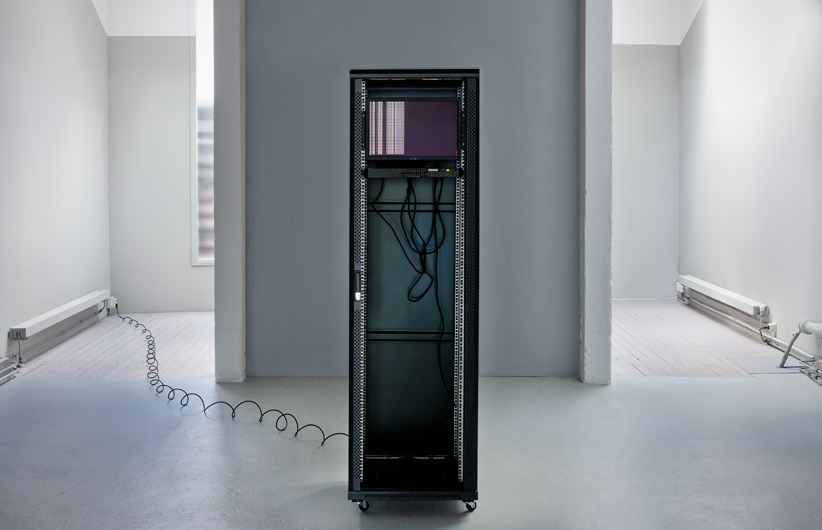
() CELLOUT.ME, 2015
installation and website,
Sloterkade 171, Amsterdam
What is the value of someone’s DNA? Can these sensitive private data simply be sold and is it possible to become the co-owner of someone else’s DNA data? In that case, what does this mean for the privacy of whoever hands over his DNA, and what does this mean for his family? DNA is the storehouse of the most personal data, the vector of hereditary information. The technique of reading out DNA is becoming easier, quicker, cheaper and thus more accessible. What are the ethical, financial and social consequences if this unique private data are traded, end up on the internet and are available to businesses and other organisations?
The Cellout.me art project investigates all these questions. Specially for KadS, Jeroen van Loon is not only exhibiting his DNA data; he is actually offering it for sale! He has given his blood to the Erasmus MC to have his DNA read out. His complete DNA sequence to laboratory standards of 380 GB has been stored on a server, and it can be consulted via a screen. He is also presenting photos of his visits to the genetic laboratory, taken by Erik Borst, and the responses of various professionals to the question of what value personal DNA data actually possesses. His DNA will be publicly auctioned via the www.cellout.me website, where people can place a serious bid in order to become joint owner of this artist’s DNA. The purchaser of this artwork will become the owner of the artist’s ultimate self-portrait.
In earlier work Jeroen van Loon examined the impact of internet and digital culture on daily life and our thinking about privacy.
Jeroen van Loon [NL, 1985] studied at the HKU in Hilversum [Digital Media Design, 2006-2010] and the HKU/The Open University, UK [European Media Master of Arts (ma), 2010]. He has given TEDx talks in the Netherlands [2012/2014], was nominated for the Designers & Artists 4 Genomics Award [2012], and won the European Youth Award [2012].
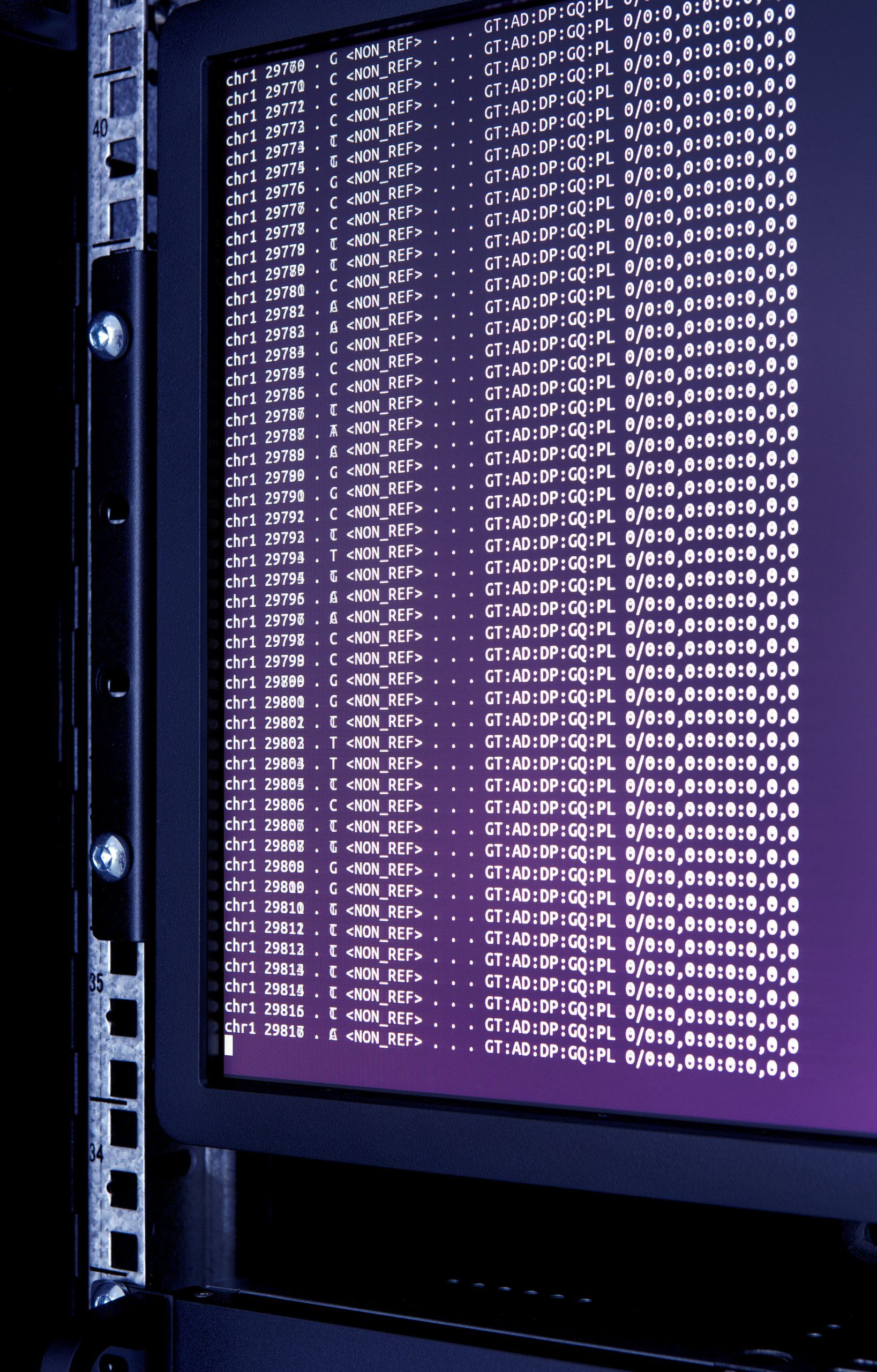
() CELLOUT.ME, 2015
installation and website,
Sloterkade 171, Amsterdam
What is the value of someone’s DNA? Can these sensitive private data simply be sold and is it possible to become the co-owner of someone else’s DNA data? In that case, what does this mean for the privacy of whoever hands over his DNA, and what does this mean for his family? DNA is the storehouse of the most personal data, the vector of hereditary information. The technique of reading out DNA is becoming easier, quicker, cheaper and thus more accessible. What are the ethical, financial and social consequences if this unique private data are traded, end up on the internet and are available to businesses and other organisations?
The Cellout.me art project investigates all these questions. Specially for KadS, Jeroen van Loon is not only exhibiting his DNA data; he is actually offering it for sale! He has given his blood to the Erasmus MC to have his DNA read out. His complete DNA sequence to laboratory standards of 380 GB has been stored on a server, and it can be consulted via a screen. He is also presenting photos of his visits to the genetic laboratory, taken by Erik Borst, and the responses of various professionals to the question of what value personal DNA data actually possesses. His DNA will be publicly auctioned via the www.cellout.me website, where people can place a serious bid in order to become joint owner of this artist’s DNA. The purchaser of this artwork will become the owner of the artist’s ultimate self-portrait.
In earlier work Jeroen van Loon examined the impact of internet and digital culture on daily life and our thinking about privacy.
Jeroen van Loon [NL, 1985] studied at the HKU in Hilversum [Digital Media Design, 2006-2010] and the HKU/The Open University, UK [European Media Master of Arts (ma), 2010]. He has given TEDx talks in the Netherlands [2012/2014], was nominated for the Designers & Artists 4 Genomics Award [2012], and won the European Youth Award [2012].
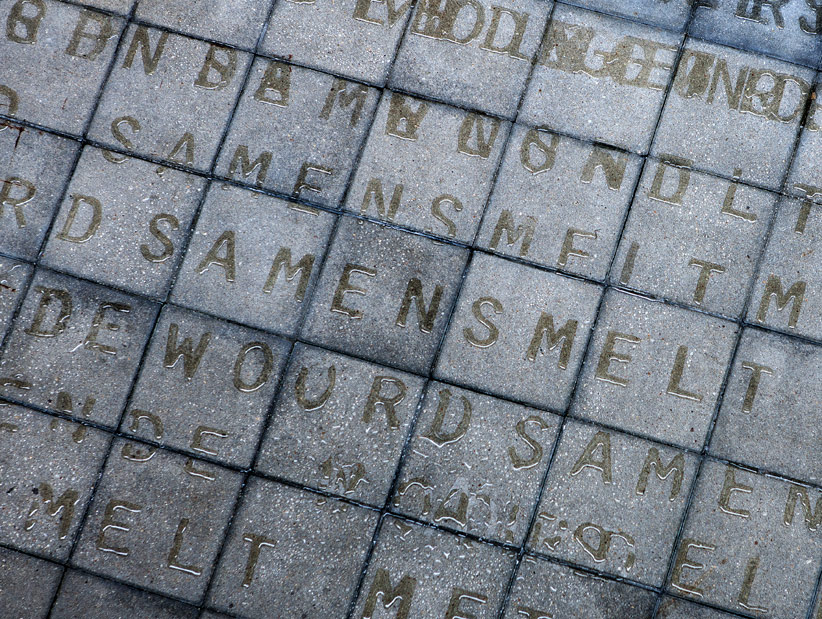
Lennart Lahuis (NS) WET SCENE STUDY NO. VI (ORATOR), 2015
installation,
Baarsstraat 15, Amsterdam
In his work, Lennart Lahuis slows down the perception of image and text. One way he achieves this, is by using transparent materials that are rendered opaque because of a literal layering. In addition, reflective surfaces make it almost impossible to fathom out the deeper layers. His installations do not give anything away and the onlooker must peer intently to gain access to and understand the image.
This same principle is used for a series of ephemeral works in which he applies poetic texts onto the floor with water. Some of the letters are not properly legible and must be slowly deciphered in the context of the other words. Like a secret code, the text is temporarily visible due to the fluid, but gradually disappears again due to evaporation.
For KadS, Lennart Lahuis has applied the following sentence in Heliomare’s courtyard using water: ‘Als elk eerste woord samensmelt met het volgende woord’ – (‘When each first word merges with the following word’). The words are superimposed and therefore almost lose their meaning. The sentence cannot be read in one go; sections of it gradually become legible and comprehensible again.
Heliomare is a centre for people with non-congenital brain damage. Many of them have a physical handicap, as their bodies do not respond well to stimuli from the brain. Some of them can no longer express their thoughts verbally because of aphasia, since there are disturbances in the linguistic faculties. The text Lennart Lahuis applied at Heliomare alludes to this.
Lennart Lahuis [NL, 1986] lives and works in France and the Netherlands. He studied at ArtEZ in Zwolle [2007-2011], LUCA in Brussels [2010], and De Ateliers in Amsterdam [2011-2013]. His work was nominated for the Royal Award for Modern Painting [2015].
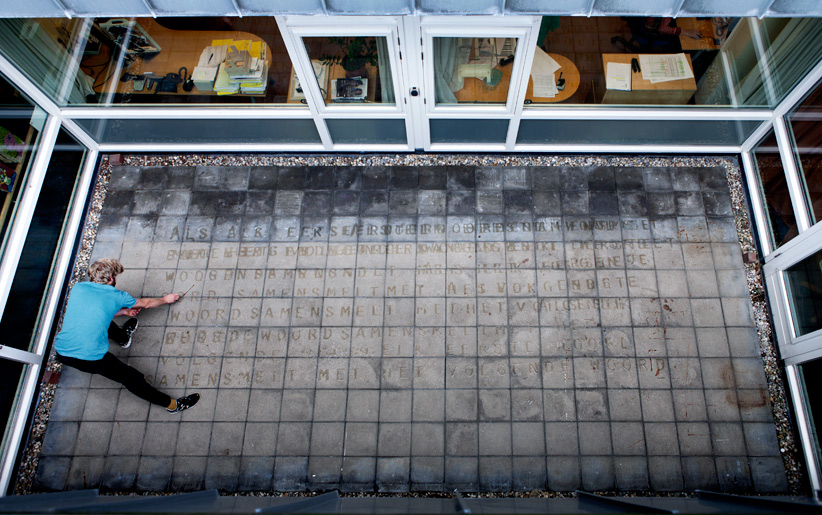
Lennart Lahuis (NS) WET SCENE STUDY NO. VI (ORATOR), 2015
installation,
Baarsstraat 15, Amsterdam
In his work, Lennart Lahuis slows down the perception of image and text. One way he achieves this, is by using transparent materials that are rendered opaque because of a literal layering. In addition, reflective surfaces make it almost impossible to fathom out the deeper layers. His installations do not give anything away and the onlooker must peer intently to gain access to and understand the image.
This same principle is used for a series of ephemeral works in which he applies poetic texts onto the floor with water. Some of the letters are not properly legible and must be slowly deciphered in the context of the other words. Like a secret code, the text is temporarily visible due to the fluid, but gradually disappears again due to evaporation.
For KadS, Lennart Lahuis has applied the following sentence in Heliomare’s courtyard using water: ‘Als elk eerste woord samensmelt met het volgende woord’ – (‘When each first word merges with the following word’). The words are superimposed and therefore almost lose their meaning. The sentence cannot be read in one go; sections of it gradually become legible and comprehensible again.
Heliomare is a centre for people with non-congenital brain damage. Many of them have a physical handicap, as their bodies do not respond well to stimuli from the brain. Some of them can no longer express their thoughts verbally because of aphasia, since there are disturbances in the linguistic faculties. The text Lennart Lahuis applied at Heliomare alludes to this.
Lennart Lahuis [NL, 1986] lives and works in France and the Netherlands. He studied at ArtEZ in Zwolle [2007-2011], LUCA in Brussels [2010], and De Ateliers in Amsterdam [2011-2013]. His work was nominated for the Royal Award for Modern Painting [2015].
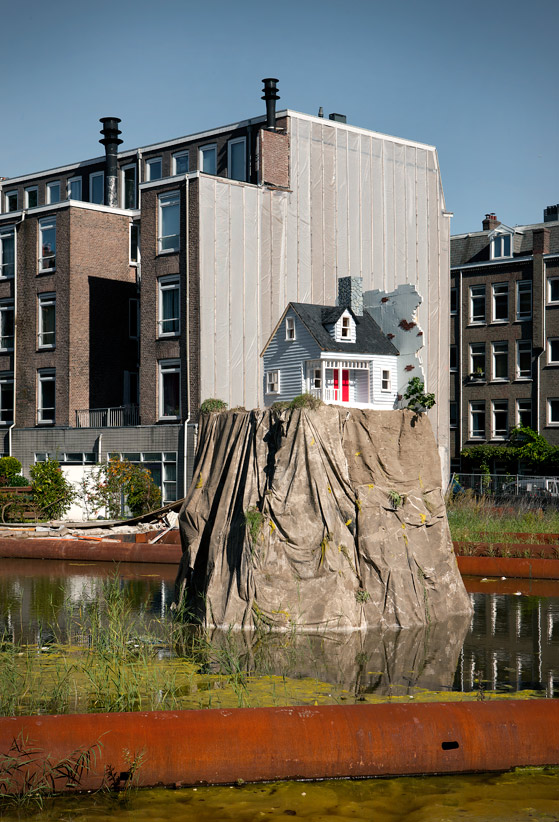
() NAIL HOUSE, 2015
installation,
Schinkelkade, Amsterdam
The Schinkelhaven nursing home stood at the Schinkelkade for many years. In 2012 it was taken down so that a new care centre could be built there. The elderly people moved into temporary accommodation, on the understanding that they would be able to return to this location. In 2015 the plans were revised and the Schinkelhaven will no longer return here.
Leonard van Munster has realised a work in the middle of this undeveloped site. On a mound of sand stands a little house with its lights on. It seems as if one of the erstwhile residents has refused to leave to make way for the new construction and the building site has therefore been excavated around this home. This work represents a form of protest and resistance, as well as a yearning for security and well-being.
Leonard van Munster usually realises temporary installations in public space. The environments are an important component of his work, which he primarily devises for a specific location. Often they are architectural structures or situations which surrealistically appear at an unexpected spot, almost as if in a dream. Examples include a tropical oasis, complete with palms and a waterfall set beneath a Dutch motorway, a floating villa on a lake and a ship which has stranded in the financial centre of Amsterdam. These are all actualised yearnings for happiness; works with an attractive appearance which can nevertheless only be viewed from a distance, because they are situated behind a fence, in the middle of a body of water or high on a mound. The contrast between the attractiveness and the sheer inaccessibility generates an intriguing tension.
Leonard van Munster [NL, 1972] studied at the Academy of Art Constantijn Huygens in Kampen [1988-1989] and the Academy of the Arts in Arnhem [1989-1990], the Rietveld Academy in Amsterdam [1992-1996], and the Parsons School of Art in New York [1994-1995].
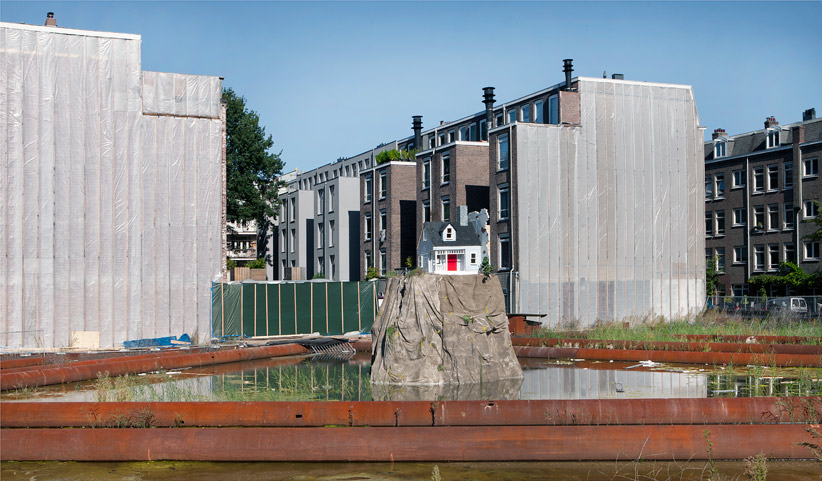
() NAIL HOUSE, 2015
installation,
Schinkelkade, Amsterdam
The Schinkelhaven nursing home stood at the Schinkelkade for many years. In 2012 it was taken down so that a new care centre could be built there. The elderly people moved into temporary accommodation, on the understanding that they would be able to return to this location. In 2015 the plans were revised and the Schinkelhaven will no longer return here.
Leonard van Munster has realised a work in the middle of this undeveloped site. On a mound of sand stands a little house with its lights on. It seems as if one of the erstwhile residents has refused to leave to make way for the new construction and the building site has therefore been excavated around this home. This work represents a form of protest and resistance, as well as a yearning for security and well-being.
Leonard van Munster usually realises temporary installations in public space. The environments are an important component of his work, which he primarily devises for a specific location. Often they are architectural structures or situations which surrealistically appear at an unexpected spot, almost as if in a dream. Examples include a tropical oasis, complete with palms and a waterfall set beneath a Dutch motorway, a floating villa on a lake and a ship which has stranded in the financial centre of Amsterdam. These are all actualised yearnings for happiness; works with an attractive appearance which can nevertheless only be viewed from a distance, because they are situated behind a fence, in the middle of a body of water or high on a mound. The contrast between the attractiveness and the sheer inaccessibility generates an intriguing tension.
Leonard van Munster [NL, 1972] studied at the Academy of Art Constantijn Huygens in Kampen [1988-1989] and the Academy of the Arts in Arnhem [1989-1990], the Rietveld Academy in Amsterdam [1992-1996], and the Parsons School of Art in New York [1994-1995].
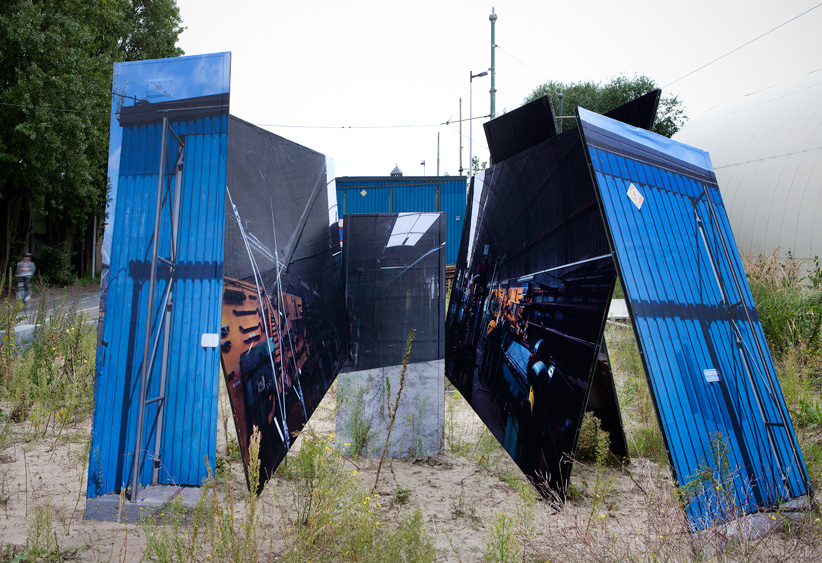
Lucia Luptáková (SK/NL) PLACES OF DISAPPEARANCE, 2015
Architectural sculpture,
Havenstraat, Amsterdam
On the periphery of the Schinkel neighbourhood lies the rough Havenstraat area. Everywhere there are sheds of corrugated material where various enterprises and individuals are at work. The activities in these warehouses are invisible. Most are enclosed and have no windows, so it’s impossible to look inside. They are secretive places that arouse curiosity. In the near future this industrial site will make way for a yet to be built residential neighbourhood.
On this site Lucia Luptáková has installed a sculpture composed of reflective panels that demarcate a space. The installation reflects its surroundings, is wholly integrated into it and thus almost invisible. Thanks to camouflage, this place might remain unnoticed and survive. Within the installation, the interior of a shed has been recreated using wall-sized photos, taken by Erwin van Amstel. In fragments, what usually remains obscure is now shown openly. Here the physical space crosses over into a mental space; the innards of the dusky shed are like the human subconscious. The work’s title refers to the disappearance of the site as it is currently arranged with all its sheds, as well as to the sculpture as a vanishing point, not merely for the work itself, but likewise for the visitors who can lose themselves within it.
The experience of space is pivotal in Lucia Luptáková’s work. This usually results in large, site-specific installations which people can enter, but recently she has also been working with photography and spatial works to scale.
Lucia Luptáková [SK/NL,1977] was born in Slovakia but lives and works in the Netherlands. She studied at the Rietveld Academy in Amsterdam [Architectural Design, 1996-2002] and the Sandberg Institute in Amsterdam [Autonomous Design (ma), 2002-2004 / Fine Arts (ma), 2004-2006].
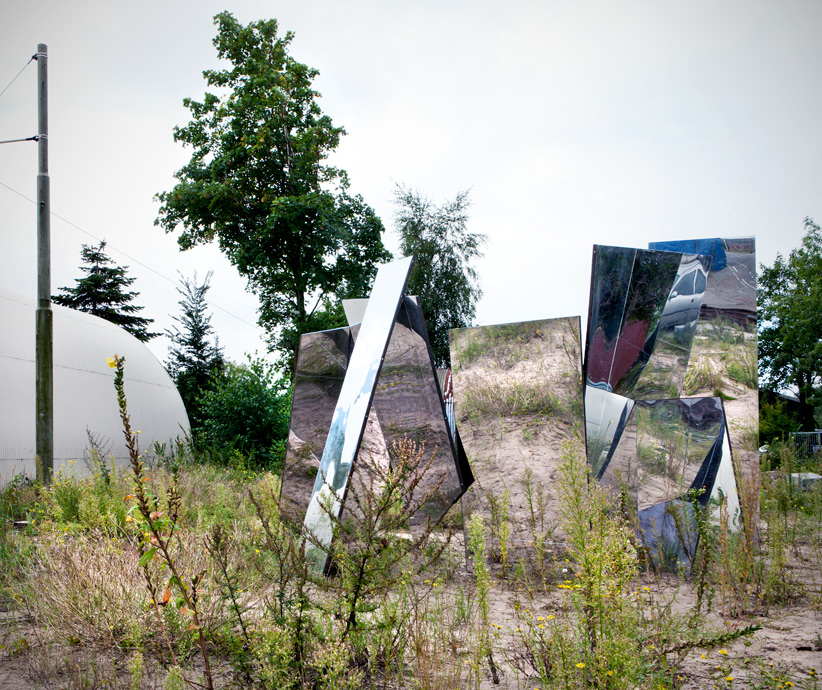
Lucia Luptáková (SK/NL) PLACES OF DISAPPEARANCE, 2015
Architectural sculpture,
Havenstraat, Amsterdam
On the periphery of the Schinkel neighbourhood lies the rough Havenstraat area. Everywhere there are sheds of corrugated material where various enterprises and individuals are at work. The activities in these warehouses are invisible. Most are enclosed and have no windows, so it’s impossible to look inside. They are secretive places that arouse curiosity. In the near future this industrial site will make way for a yet to be built residential neighbourhood.
On this site Lucia Luptáková has installed a sculpture composed of reflective panels that demarcate a space. The installation reflects its surroundings, is wholly integrated into it and thus almost invisible. Thanks to camouflage, this place might remain unnoticed and survive. Within the installation, the interior of a shed has been recreated using wall-sized photos, taken by Erwin van Amstel. In fragments, what usually remains obscure is now shown openly. Here the physical space crosses over into a mental space; the innards of the dusky shed are like the human subconscious. The work’s title refers to the disappearance of the site as it is currently arranged with all its sheds, as well as to the sculpture as a vanishing point, not merely for the work itself, but likewise for the visitors who can lose themselves within it.
The experience of space is pivotal in Lucia Luptáková’s work. This usually results in large, site-specific installations which people can enter, but recently she has also been working with photography and spatial works to scale.
Lucia Luptáková [SK/NL,1977] was born in Slovakia but lives and works in the Netherlands. She studied at the Rietveld Academy in Amsterdam [Architectural Design, 1996-2002] and the Sandberg Institute in Amsterdam [Autonomous Design (ma), 2002-2004 / Fine Arts (ma), 2004-2006].
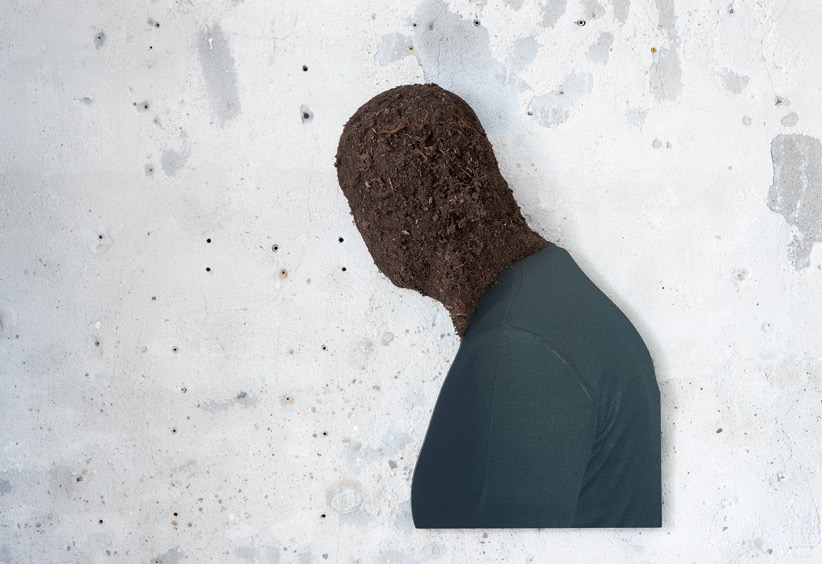
Michiel van Nieuwkerk (NL) HIDDEN PORTRAITS, 2015
Photography, laser-cut, mixed media,
Sloterkade 171, Amsterdam
Michiel van Nieuwkerk has been photographing people ever since he was a student. His speciality is indeed the photographic portrait, which he frequently produces on commission for newspapers and magazines. In his pursuit of the perfect portrait, the photos have become increasingly pared down. Characteristic of his photography is the basic visual idiom; the portraits are shot in his studio using as few extraneous means as possible. Every subject is captured in front of a neutral, plain backdrop lit by nothing but a lamp, pure without adornment, in just a couple of photos. In recent years the portraits have become so reduced that they resemble refined passport photos.
The quest for the perfect photographic portrait recently resulted in him taking a major step in his work. The people portrayed are no longer recognisable. The ultimate portrait transcends the personal and has a universal appearance. Fascinated by the space behind the photo’s surface, he decided to cut away the face in the photo. What is to be found beneath the paper’s surface, but above all what is hidden behind the façade of the face? The portrait’s deeper layers are laid bare by dissecting the photo. At the same time the excised hole is filled with a spatial, abstract form that covers the face like a mask. This intangible abstraction offers the leeway to attribute various interpretations and gives the portrait an anonymous, universal character. Michiel van Nieuwkerk is exhibiting this autonomous work for the first time during KadS.
Michiel van Nieuwkerk [NL, 1964] studied at the Academy for Photography in The Hague [1986-1990]. Since then he has primarily produced portraits for newsmagazines such as Vrij Nederland and Het Parool newspaper. In 2011 he took the initiative for the film series Dutch Masters in the 21st Century, which involved contemporary artists being portrayed by among others Michiel van Nieuwkerk.
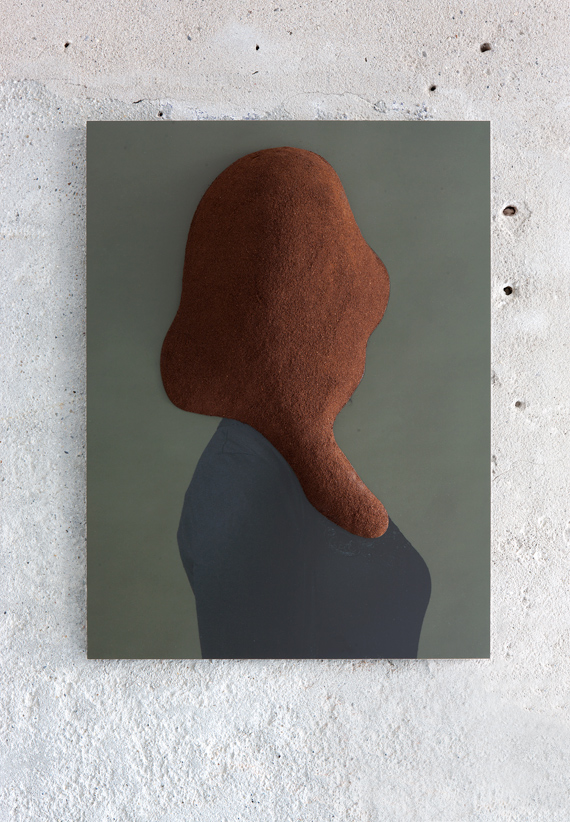
Michiel van Nieuwkerk (NL) HIDDEN PORTRAITS, 2015
Photography, laser-cut, mixed media,
Sloterkade 171, Amsterdam
Michiel van Nieuwkerk has been photographing people ever since he was a student. His speciality is indeed the photographic portrait, which he frequently produces on commission for newspapers and magazines. In his pursuit of the perfect portrait, the photos have become increasingly pared down. Characteristic of his photography is the basic visual idiom; the portraits are shot in his studio using as few extraneous means as possible. Every subject is captured in front of a neutral, plain backdrop lit by nothing but a lamp, pure without adornment, in just a couple of photos. In recent years the portraits have become so reduced that they resemble refined passport photos.
The quest for the perfect photographic portrait recently resulted in him taking a major step in his work. The people portrayed are no longer recognisable. The ultimate portrait transcends the personal and has a universal appearance. Fascinated by the space behind the photo’s surface, he decided to cut away the face in the photo. What is to be found beneath the paper’s surface, but above all what is hidden behind the façade of the face? The portrait’s deeper layers are laid bare by dissecting the photo. At the same time the excised hole is filled with a spatial, abstract form that covers the face like a mask. This intangible abstraction offers the leeway to attribute various interpretations and gives the portrait an anonymous, universal character. Michiel van Nieuwkerk is exhibiting this autonomous work for the first time during KadS.
Michiel van Nieuwkerk [NL, 1964] studied at the Academy for Photography in The Hague [1986-1990]. Since then he has primarily produced portraits for newsmagazines such as Vrij Nederland and Het Parool newspaper. In 2011 he took the initiative for the film series Dutch Masters in the 21st Century, which involved contemporary artists being portrayed by among others Michiel van Nieuwkerk.
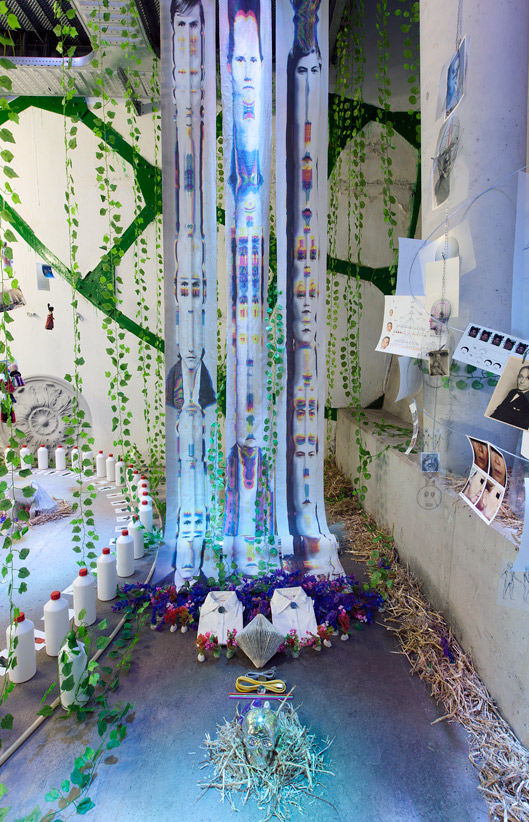
Ola Lanko (UA/NL) SHELTER, 2015
installation,
Zeilbrug, amsterdam
There is a huge basement hidden beneath the Zeil bridge which Ola Lanko has had inhabited by a certain being. It is unclear who or what this being actually is: man, beast or thing? Spread throughout the space is a large quantity of objects and photos about various subjects, such as power, equality, genetic manipulation, prolonging life and climate change. But in which era does it live? The being seems to have amassed various collections of things from what we in 2015 would call the past, present and future.
In the basement Ola Lanko has created the mental space of a hybrid being that emerged after the era of anthropocentrism. Human beings were considered at that time as the most significant entities in the world and information was spread in vast quantities and at lightning speed. It was difficult to establish connections or get a grip on reality because of the endless stream of data. The confused being has therefore withdrawn and exists safely in an underground hiding place. Here in this vacuum, detached from the outside world and without a sense of time, it has attempted to comprehend the huge stream of information by establishing collections about a number of relevant themes, and an altar to perform rituals.
Collections and archives feature often in Ola Lanko’s work, in which she usually employs the medium of photography. She captures various subjects in an analytical, almost obsessive way. Photos, as well as archives are a selective and subjective representation of reality because of the contexts and choices made. According to Ola Lanko, reality is too complex to be able to understand it swiftly and it is therefore important to take the time to look properly.
Ola Lanko [UA/NL, 1985] comes from Ukraine but lives and works in the Netherlands. She studied at the University of Kiev [Sociology, 2002-2007], the KABK in The Hague [Photography, 2008-2010], and the Rietveld Academy in Amsterdam [Photography, 2010-2012].
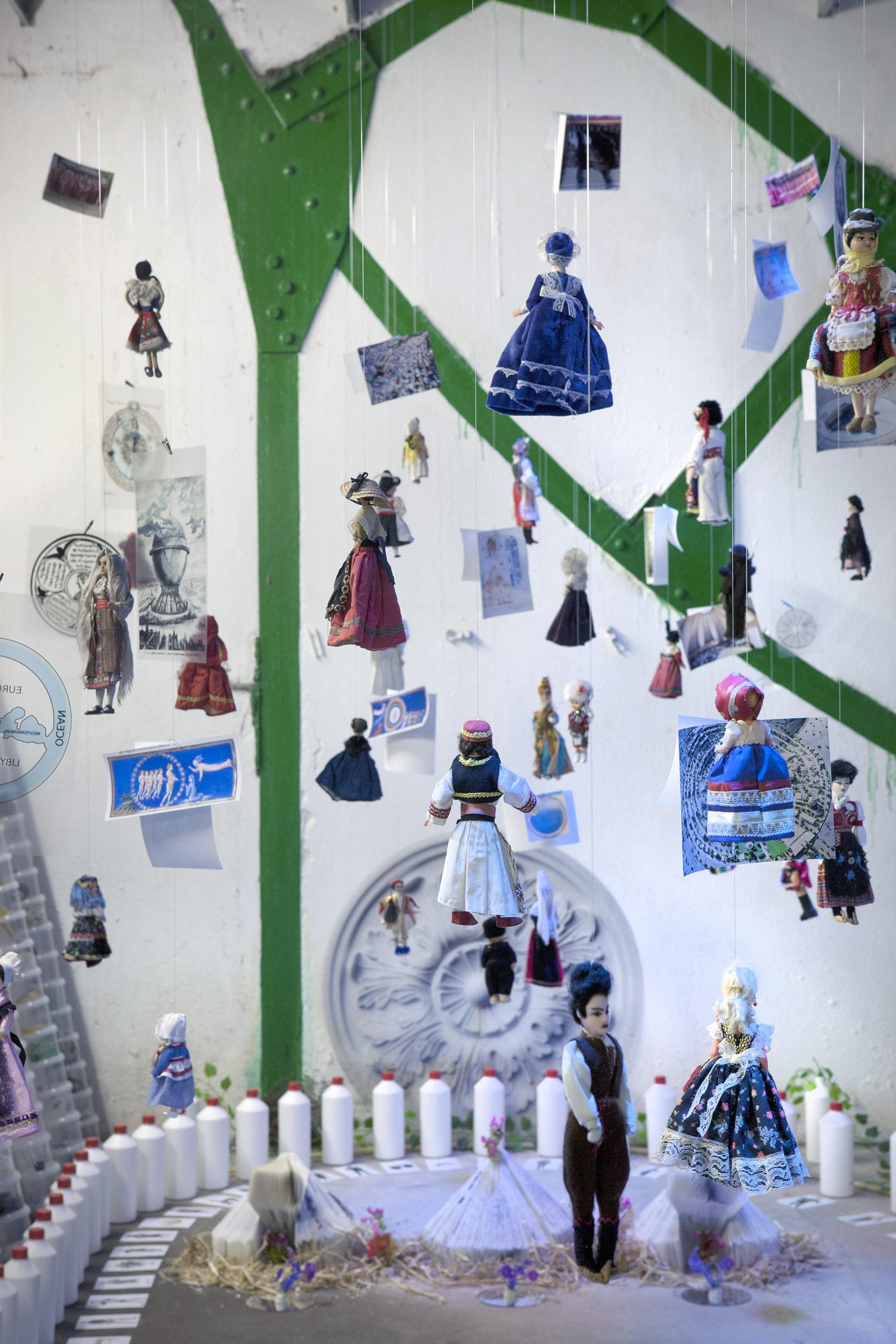
Ola Lanko (UA/NL) SHELTER, 2015
installation,
Zeilbrug, amsterdam
There is a huge basement hidden beneath the Zeil bridge which Ola Lanko has had inhabited by a certain being. It is unclear who or what this being actually is: man, beast or thing? Spread throughout the space is a large quantity of objects and photos about various subjects, such as power, equality, genetic manipulation, prolonging life and climate change. But in which era does it live? The being seems to have amassed various collections of things from what we in 2015 would call the past, present and future.
In the basement Ola Lanko has created the mental space of a hybrid being that emerged after the era of anthropocentrism. Human beings were considered at that time as the most significant entities in the world and information was spread in vast quantities and at lightning speed. It was difficult to establish connections or get a grip on reality because of the endless stream of data. The confused being has therefore withdrawn and exists safely in an underground hiding place. Here in this vacuum, detached from the outside world and without a sense of time, it has attempted to comprehend the huge stream of information by establishing collections about a number of relevant themes, and an altar to perform rituals.
Collections and archives feature often in Ola Lanko’s work, in which she usually employs the medium of photography. She captures various subjects in an analytical, almost obsessive way. Photos, as well as archives are a selective and subjective representation of reality because of the contexts and choices made. According to Ola Lanko, reality is too complex to be able to understand it swiftly and it is therefore important to take the time to look properly.
Ola Lanko [UA/NL, 1985] comes from Ukraine but lives and works in the Netherlands. She studied at the University of Kiev [Sociology, 2002-2007], the KABK in The Hague [Photography, 2008-2010], and the Rietveld Academy in Amsterdam [Photography, 2010-2012].
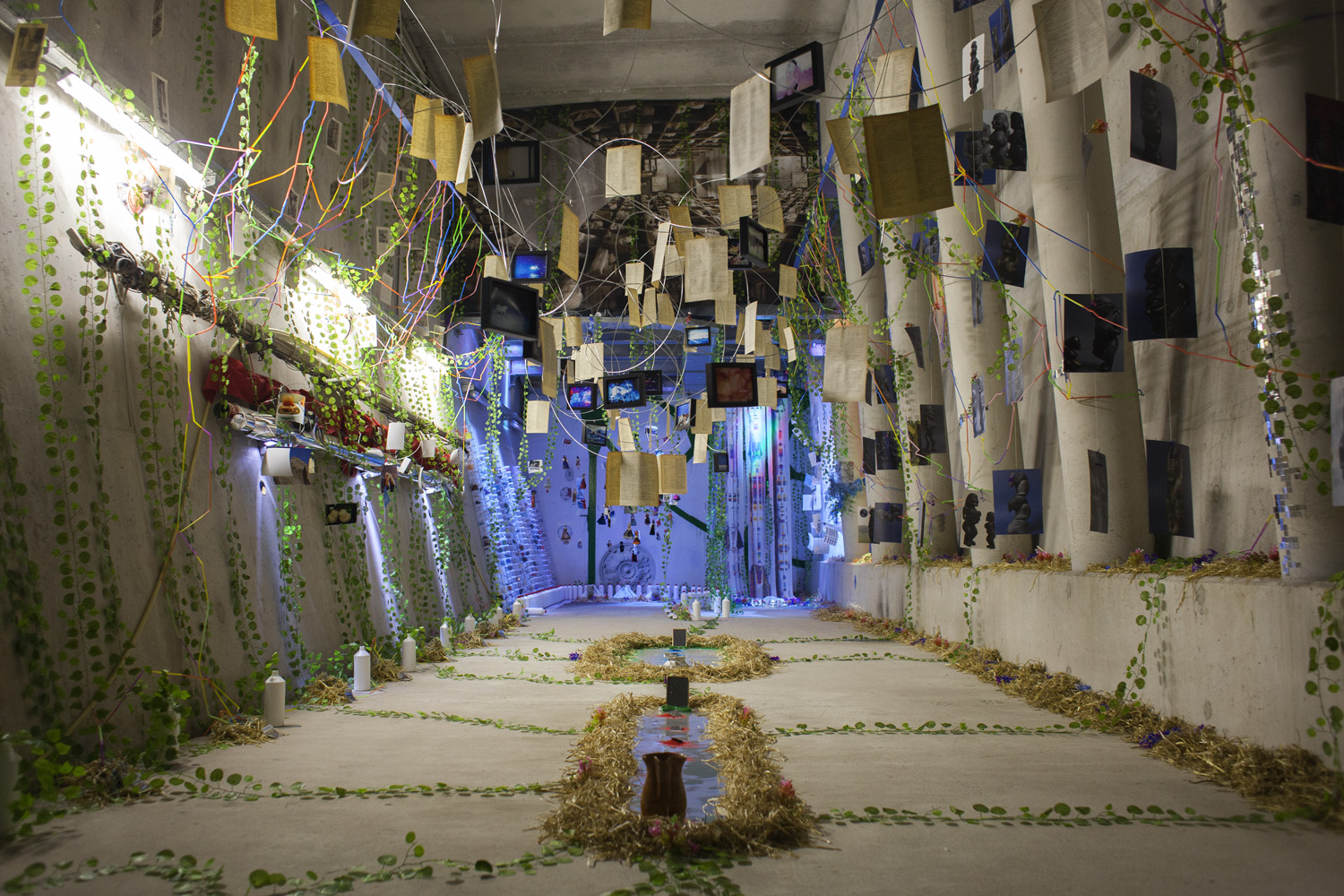
Ola Lanko (UA/NL) SHELTER, 2015
installation,
Zeilbrug, amsterdam
There is a huge basement hidden beneath the Zeil bridge which Ola Lanko has had inhabited by a certain being. It is unclear who or what this being actually is: man, beast or thing? Spread throughout the space is a large quantity of objects and photos about various subjects, such as power, equality, genetic manipulation, prolonging life and climate change. But in which era does it live? The being seems to have amassed various collections of things from what we in 2015 would call the past, present and future.
In the basement Ola Lanko has created the mental space of a hybrid being that emerged after the era of anthropocentrism. Human beings were considered at that time as the most significant entities in the world and information was spread in vast quantities and at lightning speed. It was difficult to establish connections or get a grip on reality because of the endless stream of data. The confused being has therefore withdrawn and exists safely in an underground hiding place. Here in this vacuum, detached from the outside world and without a sense of time, it has attempted to comprehend the huge stream of information by establishing collections about a number of relevant themes, and an altar to perform rituals.
Collections and archives feature often in Ola Lanko’s work, in which she usually employs the medium of photography. She captures various subjects in an analytical, almost obsessive way. Photos, as well as archives are a selective and subjective representation of reality because of the contexts and choices made. According to Ola Lanko, reality is too complex to be able to understand it swiftly and it is therefore important to take the time to look properly.
Ola Lanko [UA/NL, 1985] comes from Ukraine but lives and works in the Netherlands. She studied at the University of Kiev [Sociology, 2002-2007], the KABK in The Hague [Photography, 2008-2010], and the Rietveld Academy in Amsterdam [Photography, 2010-2012].
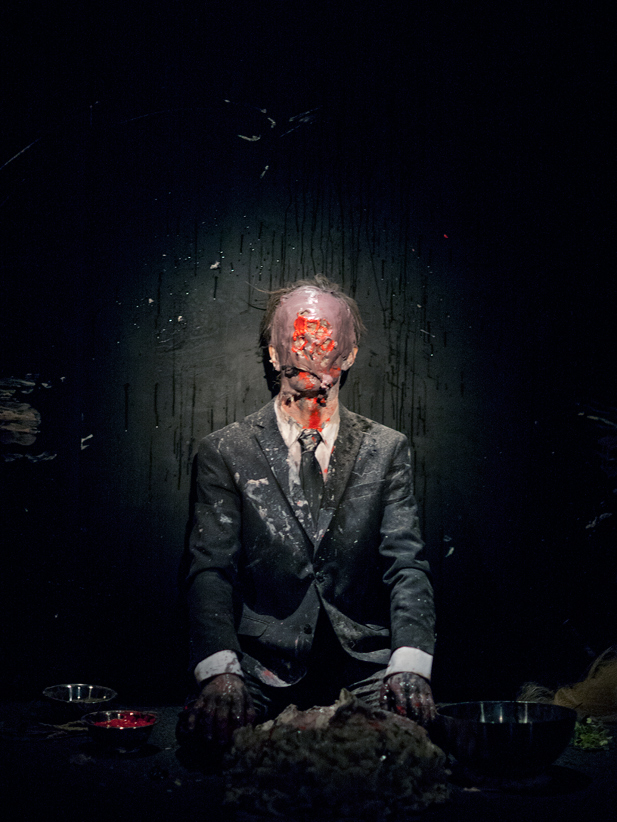
Olivier de Sagazan (FR) VOIR DERRIÈRE, 2015
performance,
teatro munganga, Amsterdam
Olivier de Sagazan combines several materials and disciplines in his work. He is simultaneously a painter, sculptor and performer. Since 2001 he has been working on the Transfiguration series of performances, which involves him applying paint and clay to his body until he becomes a living sculpture. His eyes, face and body actually end up being concealed beneath the material. During the performance he moulds his body into various guises, transforming himself into different personalities, sometimes metamorphosing into a woman or even a bird. He gradually digs into his soul and lays bare identities which usually remain hidden. With his work he is searching for the essence of humankind, for the answer to the question: ‘who am I?’
For the opening of KadS, Olivier de Sagazan has devised a new performance with clay, paint and his body and mind as vector. In the process he goes in search of the hidden places within himself and all of us. He tries to free the latent identities which are concealed underneath the surface. The former prison serves as an appropriate stage for the release of what originally was kept inside.
Olivier de Sagazan [CG/FR, 1959] was born in Brazzaville, Congo, but lives and works in France. He studied at the University of Rennes [Biology, 1979-1984]. He has been working as an artist for more than 20 years and garnered international renown with his physical performance series Transfiguration, which he has enacted all over the world.
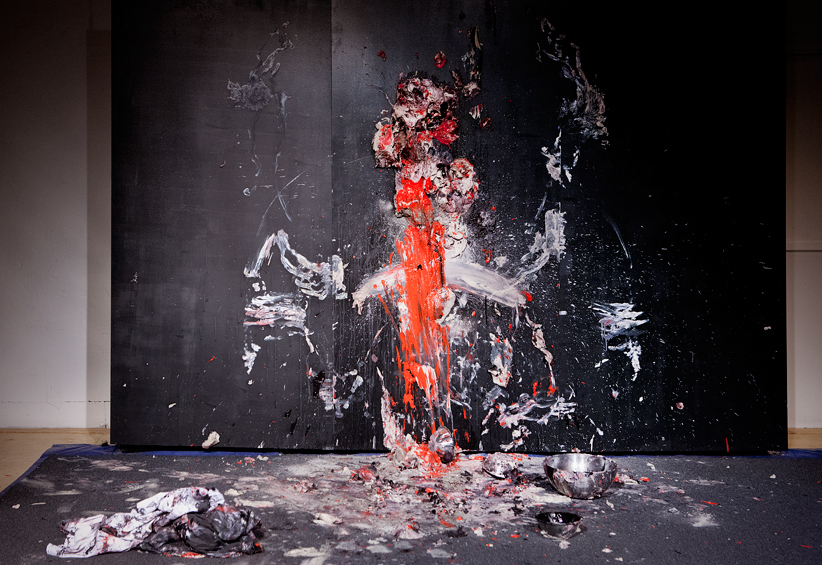
Olivier de Sagazan (FR) VOIR DERRIÈRE, 2015
performance,
teatro munganga, Amsterdam
Olivier de Sagazan combines several materials and disciplines in his work. He is simultaneously a painter, sculptor and performer. Since 2001 he has been working on the Transfiguration series of performances, which involves him applying paint and clay to his body until he becomes a living sculpture. His eyes, face and body actually end up being concealed beneath the material. During the performance he moulds his body into various guises, transforming himself into different personalities, sometimes metamorphosing into a woman or even a bird. He gradually digs into his soul and lays bare identities which usually remain hidden. With his work he is searching for the essence of humankind, for the answer to the question: ‘who am I?’
For the opening of KadS, Olivier de Sagazan has devised a new performance with clay, paint and his body and mind as vector. In the process he goes in search of the hidden places within himself and all of us. He tries to free the latent identities which are concealed underneath the surface. The former prison serves as an appropriate stage for the release of what originally was kept inside.
Olivier de Sagazan [CG/FR, 1959] was born in Brazzaville, Congo, but lives and works in France. He studied at the University of Rennes [Biology, 1979-1984]. He has been working as an artist for more than 20 years and garnered international renown with his physical performance series Transfiguration, which he has enacted all over the world.
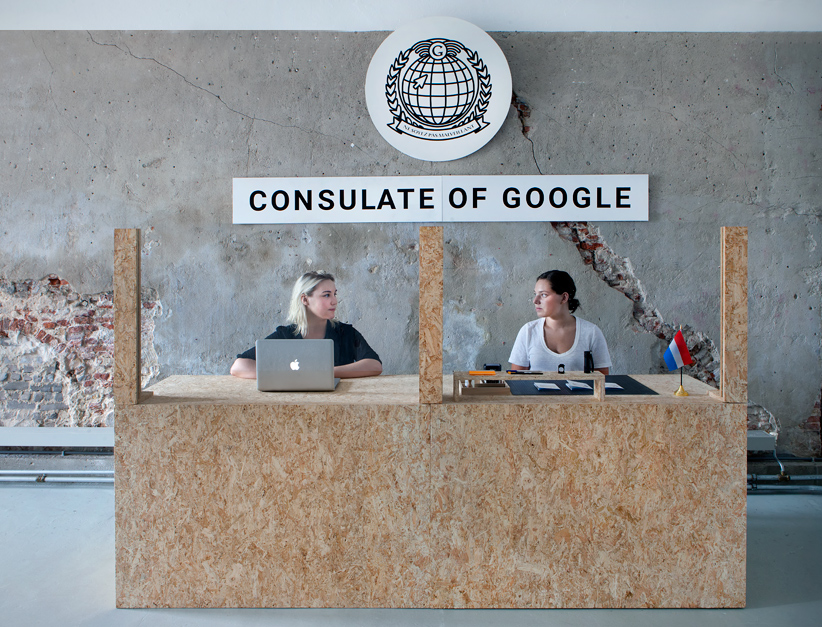
Roos Groothuizen (NL) THE CONSULATE OF GOOGLE, 2015
INTERACTIVE INSTALLATION,
Sloterkade 171, Amsterdam
What does Google know about you? And is this internet company’s impression of you correct? At Roos Groothuizen’s ‘The Consulate of Google’, everyone with a Gmail-account can have his or her smartphone or tablet searched to find his or her hidden online identity. This data profile works almost the same as a passport. Both are strictly personal and provide access to various locations. Visitors to the consulate can gain insight into their online data profile and have a Google passport produced that contains data such as gender, age group, languages and interests. The internet passport is printed out and can be picked up from the consulate after a short wait. The details are printed in such a small typeface that with the naked eye they are illegible. The private data are only gradually revealed when viewed under a microscope.
Everybody who uses the internet, unwittingly leaves behind a trail of data because of their search behaviour. This is gathered by internet companies such as Google. The Google search engine is actually a veiled advertising company that generates income by placing as many adverts as possible on websites. Google tries to discern someone’s interests, so that it can offer personally tailored adverts. The result is that internet users unconsciously become trapped in a bubble and are confronted with nothing but things that they are already familiar with or know.
As a graphic designer Roos Groothuizen is interested in how information is gathered and divulged by journalists, the media and internet in particular. It is not always obvious what is held back and therefore remains invisible. Over the last two years she has primarily been researching visual filters in the media and uncovering how these are employed.
Roos Groothuizen [NL, 1992] studied at the KABK in The Hague [Graphic Design, 2010-2015] and the Sandberg Institute in Amsterdam [Design (ma), 2015-2017].
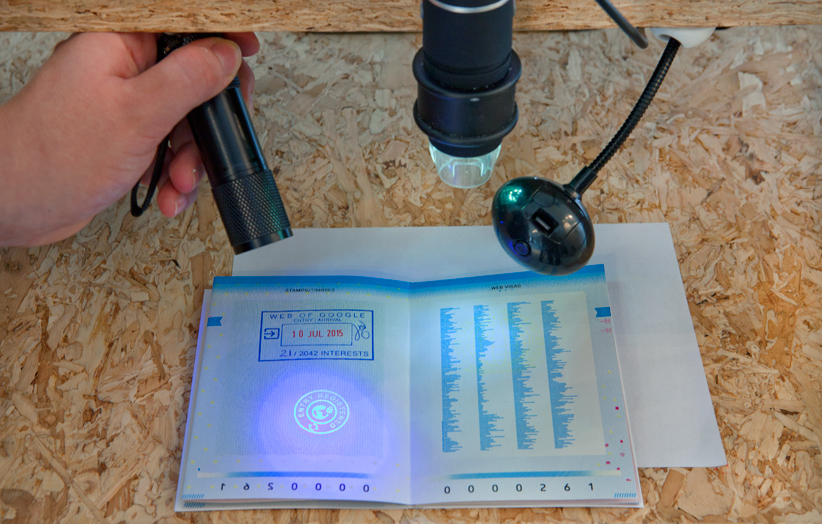
Roos Groothuizen (NL) THE CONSULATE OF GOOGLE, 2015
INTERACTIVE INSTALLATION,
Sloterkade 171, Amsterdam
What does Google know about you? And is this internet company’s impression of you correct? At Roos Groothuizen’s ‘The Consulate of Google’, everyone with a Gmail-account can have his or her smartphone or tablet searched to find his or her hidden online identity. This data profile works almost the same as a passport. Both are strictly personal and provide access to various locations. Visitors to the consulate can gain insight into their online data profile and have a Google passport produced that contains data such as gender, age group, languages and interests. The internet passport is printed out and can be picked up from the consulate after a short wait. The details are printed in such a small typeface that with the naked eye they are illegible. The private data are only gradually revealed when viewed under a microscope.
Everybody who uses the internet, unwittingly leaves behind a trail of data because of their search behaviour. This is gathered by internet companies such as Google. The Google search engine is actually a veiled advertising company that generates income by placing as many adverts as possible on websites. Google tries to discern someone’s interests, so that it can offer personally tailored adverts. The result is that internet users unconsciously become trapped in a bubble and are confronted with nothing but things that they are already familiar with or know.
As a graphic designer Roos Groothuizen is interested in how information is gathered and divulged by journalists, the media and internet in particular. It is not always obvious what is held back and therefore remains invisible. Over the last two years she has primarily been researching visual filters in the media and uncovering how these are employed.
Roos Groothuizen [NL, 1992] studied at the KABK in The Hague [Graphic Design, 2010-2015] and the Sandberg Institute in Amsterdam [Design (ma), 2015-2017].
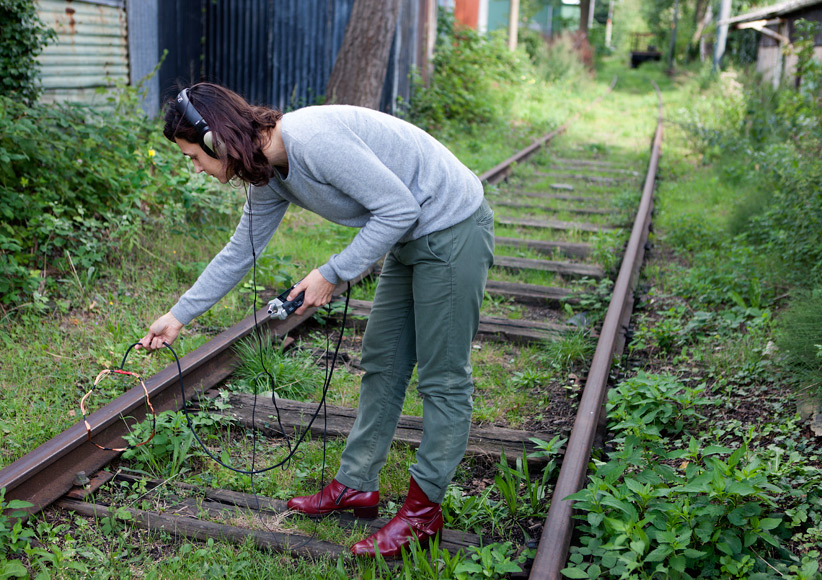
Virginie Dubois (FR) DUST AND NOISE - BALLAD ALONG THE SCHINKEL, 2015
SOUND COMPOSITION, PRINTED MAP / AUDIO TOUR,
Sloterkade 171, Amsterdam
Virginie Dubois works with sound and space as material to create soundscapes, sound installations and most recently, audio tours. In her work, she concentrates primarily on raising the listeners’ aural awareness, and their experience of sound, which naturally occurs in a particular environment. These might be the sounds of a building, within the human body, or ambient sounds in the midst of nature or in the city. It is only when one takes the time to devote true attention to one’s surroundings by listening intently, that it becomes possible to discover sounds that initially go unnoticed. Audio tours by Virginie Dubois lead the visitor along various locations to hear a diversity of
sounds. By means of a map or instructions, the attention and ears of listeners are focused on specific sounds. Along the way, the sounds gradually build into a musical composition. At the opening of Kads, Virginie Dubois will guide visitors on a live audio tour to listen to special urban sounds along the KadS-route. After the opening one can follow this listening path by means of a map. The sounds can be heard live with the naked ear. She also composed a soundscape that reveals the hidden sounds in the
Schinkel neighbourhood. With specific equipment she discovered and recorded the fascinating tones and rhythms of for example electromagnetic fields in the city that are normally not audible. Together with the poetic sounds under water, the resonance of tramways and other urban sounds, the composition enlightens and discloses some of the hidden city symphonies that surround the KadS-route.
Virginie Dubois [FR, 1977] lives and works in France as well as the Netherlands. She studied at the Royal Conservatory in The Hague [2011-2013], the KABK in The Hague [ArtScience (ma), 2011-2013], and the Sandberg Institute in Amsterdam [Design (ma), 2012-2014].
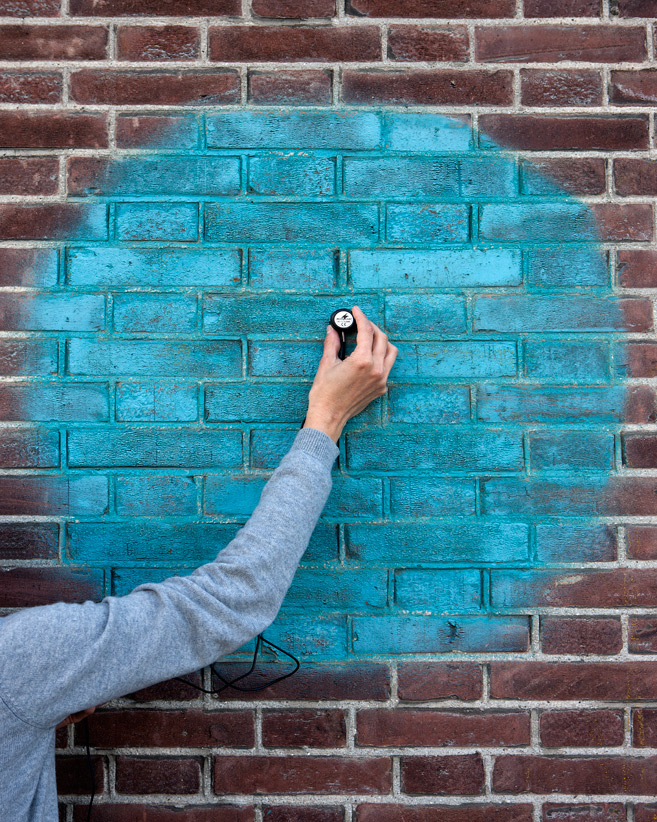
Virginie Dubois (FR) DUST AND NOISE - BALLAD ALONG THE SCHINKEL, 2015
SOUND COMPOSITION, PRINTED MAP / AUDIO TOUR,
Sloterkade 171, Amsterdam
Virginie Dubois works with sound and space as material to create soundscapes, sound installations and most recently, audio tours. In her work, she concentrates primarily on raising the listeners’ aural awareness, and their experience of sound, which naturally occurs in a particular environment. These might be the sounds of a building, within the human body, or ambient sounds in the midst of nature or in the city. It is only when one takes the time to devote true attention to one’s surroundings by listening intently, that it becomes possible to discover sounds that initially go unnoticed. Audio tours by Virginie Dubois lead the visitor along various locations to hear a diversity of
sounds. By means of a map or instructions, the attention and ears of listeners are focused on specific sounds. Along the way, the sounds gradually build into a musical composition. At the opening of Kads, Virginie Dubois will guide visitors on a live audio tour to listen to special urban sounds along the KadS-route. After the opening one can follow this listening path by means of a map. The sounds can be heard live with the naked ear. She also composed a soundscape that reveals the hidden sounds in the
Schinkel neighbourhood. With specific equipment she discovered and recorded the fascinating tones and rhythms of for example electromagnetic fields in the city that are normally not audible. Together with the poetic sounds under water, the resonance of tramways and other urban sounds, the composition enlightens and discloses some of the hidden city symphonies that surround the KadS-route.
Virginie Dubois [FR, 1977] lives and works in France as well as the Netherlands. She studied at the Royal Conservatory in The Hague [2011-2013], the KABK in The Hague [ArtScience (ma), 2011-2013], and the Sandberg Institute in Amsterdam [Design (ma), 2012-2014].